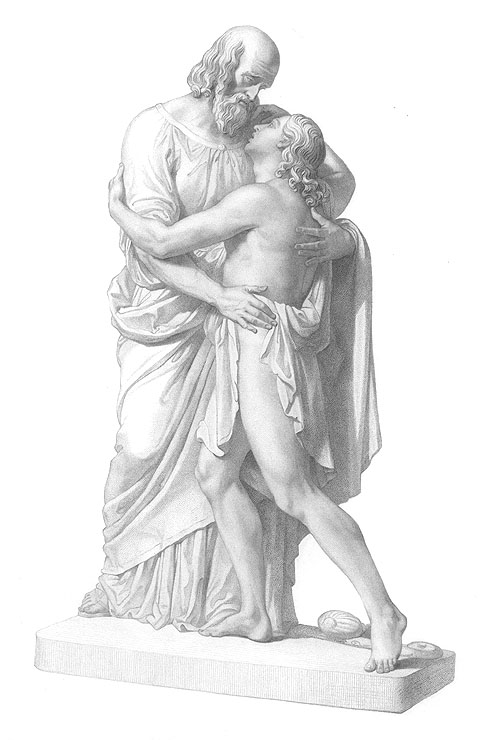|
THE PRODIGAL SON
Artist: W. Theed ____________ Engraver: J. H. Baker |
 Note: the title in the table above is printed below the engraving
Note: the title in the table above is printed below the engraving
CLICK HERE TO SEE MORE 19th CENTURY ANTIQUE PRINTS LIKE THIS ONE!!
PRINT DATE: This lithograph was printed in 1851; it is not a modern reproduction in any way.
PRINT SIZE: Overall print size is 7 1/2 inches by 10 1/2 inches including white borders, actual scene is 5 1/2 inches by 9 inches.
PRINT CONDITION: Condition is excellent. Bright and clean. Blank on reverse. Paper is quality woven rag stock paper.
SHIPPING: Buyer to pay shipping, domestic orders receives priority mail, international orders receive regular air mail unless otherwise asked for. We take a variety of payment options, more payment details will be in our email after auction close.
We pack properly to protect your item!
FROM THE ORIGINAL DESCRIPTION: We do not remember ever to have seen, prior to the exhibition of Mr. Theed's work at the Royal Academy last year, any attempt to render this eloquent subject in sculpture; it is one eminently calculated to be thus produced, as well from the nature of the incident, as for the capability it affords for picturesque and dramatic grouping. It has frequently occurred to us, that modern sculptors possess a decided advantage over ancient, in having a wider field open before them, by a more extended education, and a more intimate acquaintance with sacred and profane history, to which they may refer for subjects.
It will readily be admitted that the two figures compose into a very beautiful group, telling the tale of paternal affection and forgiveness, and of repentance, with much pathos: the attitudes of both are most striking, and blend well with each other; while the subject is treated with a purity of feeling that befits the sacred narration. At the same time, the well-formed and rounded limbs of the young man, seem scarcely to belong to one who had long fed on "the husks that the swine did eat," and was even then " perishing with hunger." He exhibits no appearance of destitutution, but, on the contrary, has all the vigor and strength of incipient manhood that knows not want. The wasted and attenuated body, would, doubtless, have exhibited the "prodigal" with more truth, but in a less attractive form. Still it must be regarded as a production that should confer no inconsiderable distinction on the sculptor, for the feeling which prompted the work and the skill that has executed it. A reduced copy of this group has been produced in parian by Messrs. Copeland for their beautiful series of statuettes.
BIOGRAPHY OF ARTIST: William, III Theed (born in Trentham, Staffs, 1804; died in London, 9 Sept 1891) was an English sculptor. He trained under his father, William Theed II (1764-1817), under Edward Hodges Baily and at the Royal Academy. In 1826 he went to Rome, where he studied under Bertel Thorvaldsen, John Gibson (i) and Richard James Wyatt. Through Gibson, Prince Albert acquired Theed's statues of Psyche and Narcissus (both marble, 1847; Osborne House, Isle of Wight, Royal Col.). This patronage prompted Theed's return to London in 1848, where further royal commissions ensued, especially after the Prince's death in 1861. Best known is Queen Victoria and Prince Albert in Anglo-Saxon Dress ('The Parting') (marble, 1862-7; Frogmore House, Berks, Royal Col.), which symbolizes Anglo-German ties and the royal marriage. Queen Victoria commissioned Theed to sculpt many other marble portraits in memory of Prince Albert. These include busts, one of them (1862) in the Blue Room, Windsor Castle, where the Prince died; two statues (1861-3 and 1863-7) at Balmoral Castle, Grampian, and a monument at St Mildred's church, Whippingham, Isle of Wight (1864).
Please note: the terms used in our auctions for engraving, etching, lithograph, plate, photogravure etc. are ALL prints on paper, and NOT blocks of steel or wood or any other material. "ENGRAVINGS", the term commonly used for these paper prints, were the most common method in the 1700s and 1800s for illustrating old books, and these paper prints or "engravings" were created by the intaglio process of etching the negative of the image into a block of steel, copper, wood etc, and then when inked and pressed onto paper, a print image was created. These prints or engravings were usually inserted into books, although many were also printed and issued as loose stand alone lithographs. They often had a tissue guard or onion skin frontis to protect them from transferring their ink to the opposite page and were usually on much thicker quality woven rag stock paper than the regular prints. So this auction is for an antique paper print(s), probably from an old book, of very high quality and usually on very thick rag stock paper.
A RARE FIND! AND GREAT DECORATION FOR YOUR OFFICE OR HOME WALL.
|

